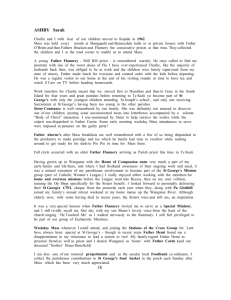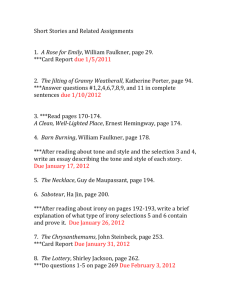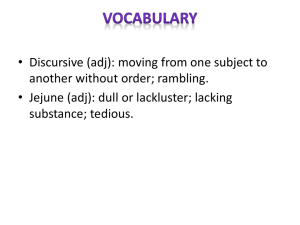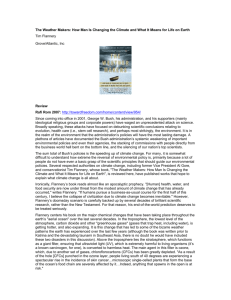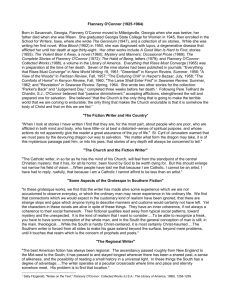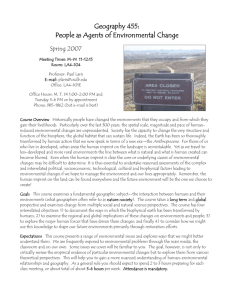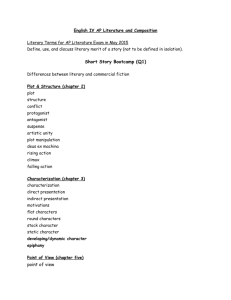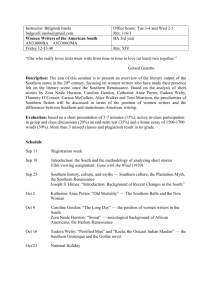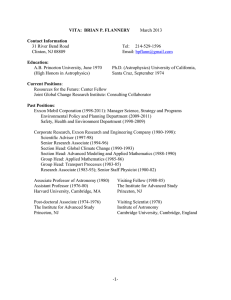Tim Flannery, The Weather Makers: The History and Future Impact
advertisement
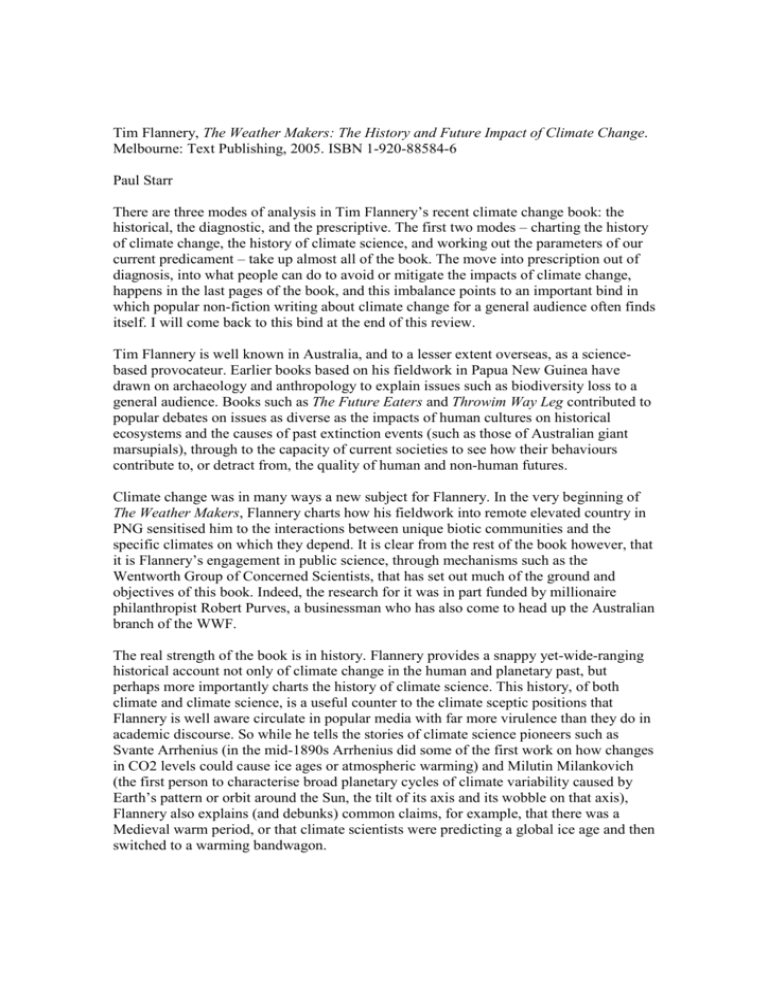
Tim Flannery, The Weather Makers: The History and Future Impact of Climate Change. Melbourne: Text Publishing, 2005. ISBN 1-920-88584-6 Paul Starr There are three modes of analysis in Tim Flannery’s recent climate change book: the historical, the diagnostic, and the prescriptive. The first two modes – charting the history of climate change, the history of climate science, and working out the parameters of our current predicament – take up almost all of the book. The move into prescription out of diagnosis, into what people can do to avoid or mitigate the impacts of climate change, happens in the last pages of the book, and this imbalance points to an important bind in which popular non-fiction writing about climate change for a general audience often finds itself. I will come back to this bind at the end of this review. Tim Flannery is well known in Australia, and to a lesser extent overseas, as a sciencebased provocateur. Earlier books based on his fieldwork in Papua New Guinea have drawn on archaeology and anthropology to explain issues such as biodiversity loss to a general audience. Books such as The Future Eaters and Throwim Way Leg contributed to popular debates on issues as diverse as the impacts of human cultures on historical ecosystems and the causes of past extinction events (such as those of Australian giant marsupials), through to the capacity of current societies to see how their behaviours contribute to, or detract from, the quality of human and non-human futures. Climate change was in many ways a new subject for Flannery. In the very beginning of The Weather Makers, Flannery charts how his fieldwork into remote elevated country in PNG sensitised him to the interactions between unique biotic communities and the specific climates on which they depend. It is clear from the rest of the book however, that it is Flannery’s engagement in public science, through mechanisms such as the Wentworth Group of Concerned Scientists, that has set out much of the ground and objectives of this book. Indeed, the research for it was in part funded by millionaire philanthropist Robert Purves, a businessman who has also come to head up the Australian branch of the WWF. The real strength of the book is in history. Flannery provides a snappy yet-wide-ranging historical account not only of climate change in the human and planetary past, but perhaps more importantly charts the history of climate science. This history, of both climate and climate science, is a useful counter to the climate sceptic positions that Flannery is well aware circulate in popular media with far more virulence than they do in academic discourse. So while he tells the stories of climate science pioneers such as Svante Arrhenius (in the mid-1890s Arrhenius did some of the first work on how changes in CO2 levels could cause ice ages or atmospheric warming) and Milutin Milankovich (the first person to characterise broad planetary cycles of climate variability caused by Earth’s pattern or orbit around the Sun, the tilt of its axis and its wobble on that axis), Flannery also explains (and debunks) common claims, for example, that there was a Medieval warm period, or that climate scientists were predicting a global ice age and then switched to a warming bandwagon. While this switching works well when Flannery is operating in historical mode, either from the geological records or from the history of science, he does sometimes over-reach himself when pushing for a populist hook. Perhaps the clearest example of how populist writing tips him too far away from history and science comes when Flannery illustrates a point about the Western Australian wheat belt and Perth’s climate-impacted rainfall figures. He claims that in Perth, ‘a taxi driver is likely to be a bankrupt wheat farmer scraping together a living as he tries to sell a now useless farm’ (129). A sentence crying out for a stern editor made it through to the final version of the book, and provided a needless support for arguments of conservative press commentators (such as in The Australian newspaper) that Flannery’s book was filled with errors and could be discounted. It is clear that the challenge of articulating activist science and history within public debates about climate change is a fraught exercise. Writers can swing all too swiftly between rigorous irrelevance or a popular accessibility at risk of damaging counterargument. While Flannery’s book does not always steer clear of error (or at least overstatement), it does retain a good fit with the journalistic and scientific discourses of popular non-fiction and its target audiences. Had Flannery not made his move into the prescriptive mode at the end of The Weather Makers, listing actions that individuals and groups can do to make a difference, he would have been open to criticism that the work provided no answers, only a doom-ridden account of our past mistakes and contemporary dilemmas. But too much of a focus on behaviour change, on change in institutions, cultures and societies, risks having the book read like a polemic and utopian tract. There is also a difficulty of comparative rigour involved: readers have a familiarity with evidenced-based historical narrative and argument, but are less familiar with how well-founded and feasible alternate futures can be written in a non-fiction mode. This bind – of how to look to the provision of an alternate future without turning the balance of a book away from a grounding in history and scientific evidence – is one common to much popular non-fiction writing on climate change. Flannery’s way out of the bind is to minimise the length of the prescriptive component of the book, and to make it clear that those actions he does identify – such as a consumer-driven switch to accredited green power – are only first steps on a much longer path. Other writers have taken different tacks. James Gustave Speth somewhat unsuccessfully tries to integrate some of the strategy-development approaches of academic futuring in his book, Red Sky at Morning. Mark Lynas’s High Tide personalises change, dwelling on his own decisions to forego further international air travel because of the climate changes impacts of aviation. Neither option taken achieves a convincing balance of historical, diagnostic and prescriptive modes, but it may be that such a balance is impossible, and the cause of change best served by giving alternate futures spaces of their own, and not confining them to closing words and afterwards. Works cited Flannery, Tim. The Weather Makers: The History and Future Impact of Climate Change. Melbourne: Text Publishing, 2005. Speth, James Gustave. Red Sky at Morning: America and the Crisis of the Global Environment. New Haven and London: Yale University Press, 2004. Lynas, Mark. High Tide: The Truth About Our Climate Crisis. New York: Picador, 2004.

